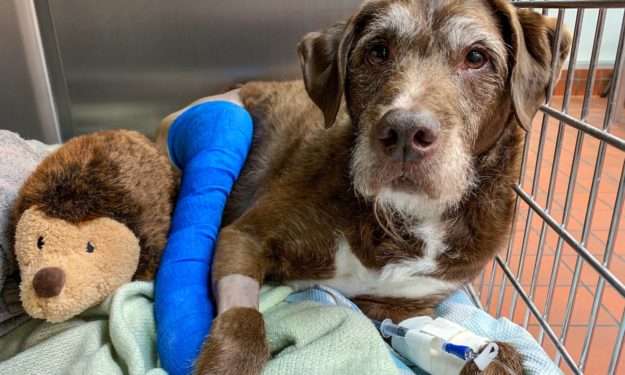Long Road to Recovery: Cranial Cruciate Ligament Tear

I watched Luka whip around the yard with his pal, both tails wagging and tongues flying. Then almost as quickly as he pivoted and changed direction to avoid his friend from gaining on him, I saw Luka come to a stop and hobble over to me. He was non-weight bearing on his right hind leg.
The Diagnosis:
We drove right to Bulger to be seen and after a full exam, we took the ‘wait and see’ approach with the possibility of a strain. We set a follow-up appointment with Luka’s primary care veterinarian, Dr. Bennett, for later that week.
With rest and Rimadyl, he was not improving, so at our recheck Dr. Bennett consulted with the Surgeon, Dr. Blaeser, to get her opinion. Radiographs of his knee confirmed what I was dreading: a torn CCL (ACL). Dr. Blaeser went over the surgical options with me and decided the lateral suture would be the best form of treatment for the tear Luka had.
I was terrified about Luka going into surgery. Not because I didn’t trust the team, because no one wants to see their pet in pain or go through a surgery without being able to explain it to them; why this is happening to them. The surgery department had a cancelation, so his surgery was set for the next day and now I had to get everything prepared for his recovery.
Preparation for Surgery:
Post-op care for an orthopedic surgery is detailed and strict. Your pet is going through a big ordeal and it is being paid for out of your pocket, so you want to make sure you do everything you can to ensure the surgery is a success. I purchased a new crate that was a bit bigger for him that I could place a large orthopedic pet mattress in. The first two weeks post-op, your dog will spend a good amount of time confined to their crate.
To be honest, I was feeling so anxious and overwhelmed for the surgery that was happening the next day, that I didn’t think about what I would need for the next few days to help me, help him. Groceries for one! When I took Luka home on Saturday, I thought I had prepared the house well with slip free mats scattered in the path he would normally take, his comfy crate, and water bowls he could reach while laying down. I hadn’t thought about myself and realized 24 hours in that I had been obsessing over him and following his medication and ice routine that I hadn’t eaten. I felt guilty leaving him alone. Because of this I wanted to gather a list of items that may help prepare you before picking your dog up from the hospital post-operation.
Checklist for post-op care:
- Prepare or purchase a crate large enough for your pet to stand up and turn around in
- Purchase water bowls that attach to your dog’s crate
- Check your dog’s food supply
- If you have wood floors, lay out some slip-free mats around their food bowl and the path they normally take through the house to outside
- Make sure you have some ice packs and a warm compress
- Before picking your pet up, ensure you have easy meals for yourself and your family to have over the next few days
- If your dog is difficult to give medications to, have some peanut butter or pill pockets on hand
The Surgery:
The surgery team did a wonderful job and Luka’s surgery went perfect. His ligament was torn 75%, but his meniscus was healthy. The surgery was a success. Luka spent the night in the ICU where 24-hour technicians and doctors monitored and treated him over night. He had a nerve block that Dr. Blaeser administers which has an extended release for three days. So all in all, he was very comfortable, if not a bit loopy.
The Recovery:
For two weeks post-op dogs are on very restricted movement. There are discharge instructions with a great set of recommendations for what you should be doing day to day from icing and heat, to stretches and range of motion. Once his sutures were removed at the two week mark, we headed down to Massachusetts Veterinary Referral Hospital to see Ingrid Bredas in the Sports Medicine and Rehabilitation department for physical therapy.
Ingrid spent a long time explaining her plan to me as she examined Luka for the first time. His plan included an array of exercises and strengthening techniques and the underwater treadmill. At this date, he is now 8 weeks post op and going for physical therapy once a week for a total of 6-7 weeks. He has some hiccups and setbacks, but his medical teams both at Bulger and Mass Vet have been with us the whole way helping him get stronger.
Now What?
This is a long recovery and at times you may feel defeated, frustrated, or even guilty for not being better in your dog’s recovery. Lean on your veterinary teams. They have reassured me every step of the way and were always willing to call me back with any little worry. I can’t tell you from experience yet that it will all work out and you will get through it fine, but if anything does cause a setback, your veterinarians will be there to correct it. They have clearly shown me that they truly care about the recovery process and being present long after the surgery was complete.